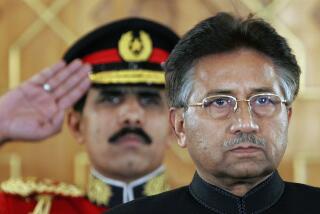Pervez Musharraf’s Extremist Dilemma
- Share via
ISLAMABAD — It has been less noticed, certainly. But the disappearance of pro-Taliban Islamic extremists from the streets of Pakistan has been even more rapid than the withdrawal of Taliban forces from Kabul.
The Taliban’s dramatic and sudden fall was surprising even to the regime’s opponents. To Pakistani supporters, the defeat was shocking. Early in the war, tens of thousands of members of Pakistani Islamic groups flooded the streets, protesting the U.S.-led military action in Afghanistan and vowing to participate in a jihad on the side of their Taliban brethren. But with each Taliban retreat, more and more protesters became confused and decided to stay home during the demonstrations.
This unexpected reaction by Pakistani fundamentalists could certainly strengthen the hand of Pakistan’s military ruler, Gen. Pervez Musharraf, who now appears determined to take further action against them. Musharraf is currently preparing an ambitious plan to wipe out the Islamic extremist movement in the country. But it remains to be seen whether he will actually go fully forward with the plan.
In the end, the ruling establishment’s domestic and regional objectives may militate against its taking all-out action against these extremist groups.
Since the start of the war on terrorism in Afghanistan, Musharraf has been in a difficult position. His controversial decision to join the anti-terrorism coalition has forced him to walk a political tightrope at home and abroad and has made him the most vulnerable military ruler the country has ever had.
The Pakistani militants who went to Afghanistan to take part in what they thought was a jihad, or holy war, fell into two distinct groups. One was composed of some 3,000 to 4,000 members of Pakistan-based Islamic militant organizations that regarded Taliban-controlled Afghanistan as the base for a much larger, pan-Islamic movement. Their philosophy is similar to that of Osama bin Laden and his Al Qaeda movement. Along with Arab militants, these Pakistanis put up the fiercest resistance in Afghanistan.
The other group of Taliban supporters consists primarily of emotional Pakistani Pushtun tribesmen (the same ethnic group as the Taliban) who went to Afghanistan as soon as the U.S. military strikes began. Supporters of a local Islamic fundamentalist movement known as the Movement for the Enforcement of Islamic Laws, these men, numbering between 5,000 and 8,000, were led into battle by the movement’s leader, Mullah Sufi Mohammed, a fanatic from the northwest who in the mid-1990s led an armed fundamentalist uprising in the Malakand region. Mohammed’s followers this time picked up their guns--in many cases their World War II rifles--and crossed into Afghanistan to fight in the jihad declared by Mullah Mohammed Omar. Most of them were killed or arrested when the Northern Alliance launched its ground assault.
When Mohammed returned to Pakistan, he had with him fewer than 50 of these men. None of them resisted arrest by border guards, preferring prison to the criticism they would get from relatives of the missing. During this period, there was no organized effort to secure the release of the detained leaders of Pakistan’s three most prominent Islamic groups, who had been picked up by Pakistani authorities after leading a violent protest campaign at the beginning of the war. Once the Taliban started retreating, these Islamic leaders apparently preferred to remain in their respective detention centers--in two cases, their own homes--lest they be asked by their supporters to either explain the fall of the Taliban or to organize more street protests. After having built up the image of Taliban fighters to mythic proportions, it would have been awkward for them to explain the Taliban’s quick destruction.
These events discredited many fundamentalist mullahs, which makes it much easier for Musharraf to move against Islamic hard-liners, who now regard him as an even bigger enemy than the United States. His first step may be to take aim at the fundamentalist Islamic schools known as madrasas, some of which provide military training in addition to Koran studies and encourage hatred of the United States. A document prepared by the country’s intelligence services and presented to Musharraf during a recent meeting on internal security offers some graphic details about these seminaries. There are about 4,500 such schools in Pakistan. Most are not involved in extremist politics, but their limited curriculum, mostly confined to teaching the Koran, has produced a generation of narrow-minded, semi-illiterate people. Of more concern are the hundreds of madrasas run by politico-religious groups with the specific goal of building cadres of Islamic fundamentalists in the country.
Initially, Musharraf wants to go after those Islamic seminaries that are involved in sectarian violence in the country. Additionally, he plans to stop foreign funding of religious schools and require them to expand their curricula to include academic subjects like science and history. His plan also includes banning Islamic groups that have been involved in sectarian violence in the country.
While these laudable goals would introduce some sanity to Pakistan’s domestic political and social affairs, accomplishing them will be difficult. Similar attempts in the past have not been successful, and many skeptics doubt that Musharraf will find the task any easier. In fact, a crackdown on Islamic seminaries could backfire. In the past, they have been a breeding ground not just for the moujahedeen holy warriors fighting in Afghanistan, but also for those fighting in Indian-administered Kashmir.
As much as Musharraf may want to crack down, Kashmir is a huge issue for many Pakistanis, who genuinely support the armed struggle against Indian forces there. In such a situation, what remains to be seen is whether Musharraf can rein in the Islamic extremists within the country without affecting Pakistan’s decades-old policy of supporting militants in Indian-controlled Kashmir.
More to Read
Sign up for Essential California
The most important California stories and recommendations in your inbox every morning.
You may occasionally receive promotional content from the Los Angeles Times.










